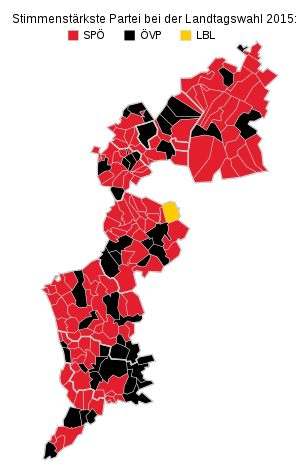State election in Burgenland 2015
The state elections in Burgenland 2015 took place on May 31, 2015; it was the 21st election of the Burgenland Landtag . In this regular election, 36 MPs were elected.
Starting position
In the state elections in 2010 , the Social Democratic Party of Austria (SPÖ) had 48.26% of the votes and thus no longer an absolute majority. The 18 mandates in the state parliament, which corresponded to this result, were not enough to achieve an absolute mandate majority, so that a working agreement was reached with the Austrian People's Party (ÖVP). The ÖVP received 34.6% of the vote and thus 13 state parliament mandates. In addition, due to the proportional representation system still in force at the time, the SPÖ received four government members in the Burgenland provincial government and once again provided the governor with Hans Niessl , while the ÖVP sent three government members and Franz Steindl the deputy governor.
In addition, the Freedom Party of Austria (FPÖ) with 8.98%, the Greens with 4.15% and the Burgenland list with 4.0% of the votes also received mandates in the Burgenland Landtag.
Changes to the electoral law
After the previous system of proportional representation for the occupation of the state government was abolished in Burgenland by the state constitutional law in 2014 , the state election in 2015 was the first election in Burgenland after which a free government was formed. As a result of this change in electoral law, the party with the strongest vote invites to government negotiations with potential coalition partners after the election. At the same time, an early second election day was introduced and the previously applicable percentage hurdle for attaining individual preferred vote mandates was abolished, so that at least one mandate, possibly the only one, goes to the candidate with the most preferred votes on his electoral list.
Campaigning parties
The following parties ran for election:
- Social Democratic Party of Austria (SPÖ)
- Austrian People's Party (ÖVP)
- Freedom Party of Austria (FPÖ)
- The Greens - The Green Alternative (GREEN)
- Alliance List Burgenland (LBL)
- NEOS - The New Austria and Liberal Forum (NEOS)
- Christian Party of Austria (CPÖ)
The Burgenland List, which was drawn into the State Parliament in 2010, joined the Stronach team under the name of Bündnis Liste Burgenland.
Candidates
A total of 412 people will stand for the state elections in Burgenland on May 31st. With 275 candidates and 137 female candidates, the proportion of women is 33.25%. There are significant differences between the participating parties in this regard. With 53% women, the Greens are not only the clear front runner, they are also the only party for which more women than men are running. The FPÖ (12%) and the CPÖ (10%) have by far the lowest proportion of women. In contrast, there are hardly any differences between the parties with regard to the average age of the candidates. This is between 50 years (CPÖ) and 45 years (ÖVP).
Survey
When asked which party the Burgenlanders would vote for, the state elections would take place next Sunday, the respondents answered as follows:
(Note: The statistical range of fluctuation (deviation) is between 3 and 5 percentage points.)
| Institute | date | SPÖ | ÖVP | FPÖ | GREEN | LBL | NEOS | Others |
|---|---|---|---|---|---|---|---|---|
| Gallup | 04/24/2015 | 44% | 31% | 13% | 6% | 3% | 3% | n / A |
| Hajek | 04/14/2015 | 46% | 30% | 12% | 6% | 3% | 3% | n / A |
Results
Of the 250,607 eligible voters, 190,556 (76.04%) cast their votes. The turnout was slightly lower than in the previous election in 2010 (77.30%). 4,595 votes (2.41%) were deemed invalid. The valid 185,961 votes were distributed among the parties as follows:
| Political party | be right | percent | Seats | +/- percent | +/- seats | |
|---|---|---|---|---|---|---|
| SPÖ | 77,947 | 41.92% | 15th | 6.34% | 3 | |
| ÖVP | 54,080 | 29.08% | 11 | 5.54% | 2 | |
| FPÖ | 27,964 | 15.04% | 6th | 6.06% | 3 | |
| GREEN | 11,964 | 6.43% | 2 | 2.28% | 1 | |
| LBL | 8,970 | 4.82% | 2 | 0.82% | 1 | |
| NEOS | 4,337 | 2.33% | 0 | 2.33% | ||
| CPÖ | 699 | 0.38% | 0 | 0.38% | ||
consequences
As early as June 5th, the incumbent governor and SPÖ chairman Hans Niessl and the FPÖ chairman Johann Tschürtz announced that they wanted to form the Niessl IV coalition government for the coming legislative period from representatives of their two parties. This decision broke the SPÖ guideline not to cooperate with the FPÖ at the government level. It led to controversial discussions and protests at the state and federal levels.
Web links
- Province of Burgenland Municipal, regional and federal elections
- Analyzes of the 2015 state elections on the website of the SORA Institute
Individual evidence
- ↑ https://wahl.bgld.gv.at/wahlen/lt20150531.nsf
- ^ Fixed constitutional reform: SPÖ and ÖVP agree . Article on burgenland.orf.at from September 16, 2014.
- ↑ Declarations of support for Burgenland Election 2015: Status and Updates | neuwal.com | 2015, burgenland, state election, declarations of support. Accessed April 11, 2018 (German).
- ↑ Alliance List Burgenland wants to "clear out" . ( bvz.at [accessed on April 11, 2018]).
- ↑ meinparlament.at - in dialogue with politics. Retrieved April 11, 2018 .
- ↑ meinparlament.at - Burgenland state election - statistics. Retrieved April 11, 2018 .
- ↑ oe24.at: [1]
- ↑ orf.at: [2]
- ↑ State election 2015: election result. Burgenland Government, accessed on June 4, 2015 .
- ↑ Red-blue government fixed orf.at Burgenland from June 5, 2015, accessed on June 9, 2015
